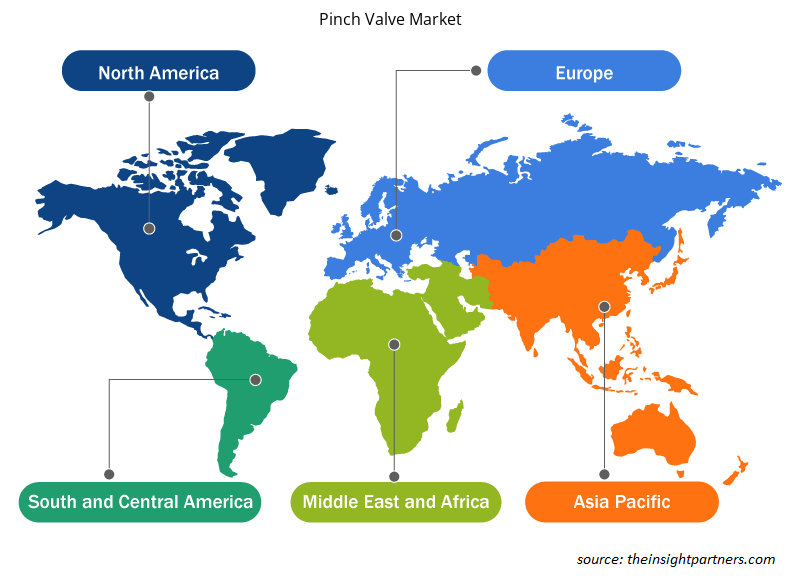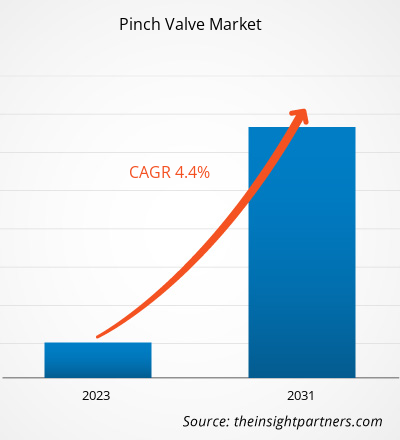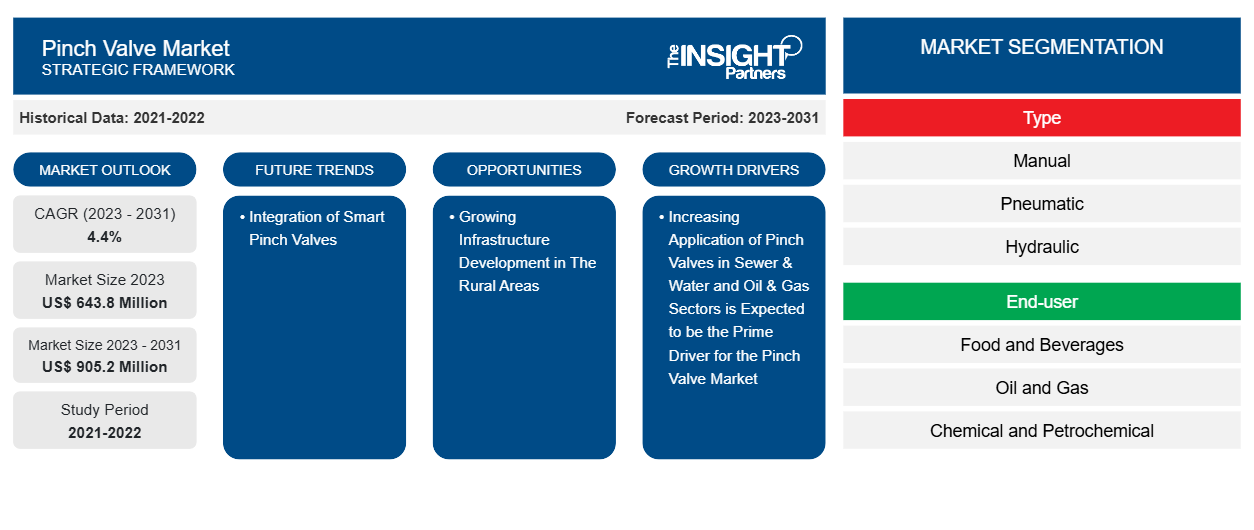Der Markt für Quetschventile soll von 643,8 Millionen US-Dollar im Jahr 2023 auf 905,2 Millionen US-Dollar im Jahr 2031 anwachsen. Der Markt soll zwischen 2023 und 2031 eine durchschnittliche jährliche Wachstumsrate von 4,4 % verzeichnen. Die wachsende Entwicklung der Öl- und Gasindustrie sowie der zunehmende Fokus der Regierung auf die Erhöhung der Zahl von Wasser- und Abwasseraufbereitungsanlagen sind die Haupttreiber für das Wachstum des Quetschventilmarktes weltweit.CAGR of 4.4% during 2023–2031. The growing development of the oil & gas industry, along with rising government focus on increasing the number of water and wastewater treatment facilities, are acting as major drivers for the growth of the pinch valves market globally.
Quetschventil Marktanalyse
Die boomenden Öl- und Gas-, Petrochemie- und Chemiebranchen haben die Nachfrage nach Quetschventilen in die Höhe getrieben, da sie eine wichtige Rolle bei der Steuerung des Flüssigkeitsflusses in industriellen Anlagen spielen. Darüber hinaus fördern die steigende Zahl von Öl- und Gasraffinerien und zunehmende staatliche Initiativen zur Steigerung der Zahl von Wasser- und Abwasseranlagen den Einsatz von Quetschventilen auf globaler Ebene. Das Abwasservolumen steigt aufgrund des Bevölkerungswachstums. Industrie und Haushalte erzeugen den Großteil des Abwassers. Weltweit werden jedes Jahr etwa 380 Milliarden Kubikmeter kommunales Abwasser produziert, was den Bedarf an einer angemessenen Infrastrukturentwicklung im Abwasser- und Wassersektor erhöht. Somit treibt die wachsende Bevölkerung den Markt für Quetschventile an.
Quetschventil Marktübersicht
Der Markt für Quetschventile wird nach Typ, Endverbraucher und Geografie kategorisiert. Basierend auf dem Typ wird der Markt in manuelle, pneumatische, hydraulische und elektrische Ventile segmentiert. Basierend auf dem Endverbraucher wird der Markt in Lebensmittel und Getränke, Öl und Gas, Chemie und Petrochemie, Wasser und Abwasser und andere unterteilt. Die wachsende Zahl von Öl- und Gasanlagen sowie ein zunehmender Fokus auf ordnungsgemäße Abwasser- und Entwässerungsanlagen zur Einhaltung der Hygiene sind ein Schlüsselfaktor, der den Einsatz von Quetschventilen fördert. Die wachsende Bedeutung von Wasser- und Abwasseraufbereitungsanlagen zur Aufrechterhaltung der Umwelthygiene und die zunehmende Entwicklung intelligenter Städte werden voraussichtlich auch das Wachstum des Quetschventilmarktes im Prognosezeitraum vorantreiben.
Passen Sie diesen Bericht Ihren Anforderungen an
Sie erhalten kostenlos individuelle Anpassungen an jedem Bericht, einschließlich Teilen dieses Berichts oder einer Analyse auf Länderebene, eines Excel-Datenpakets sowie tolle Angebote und Rabatte für Start-ups und Universitäten.
-
Holen Sie sich die wichtigsten Markttrends aus diesem Bericht.Dieses KOSTENLOSE Beispiel umfasst eine Datenanalyse von Markttrends bis hin zu Schätzungen und Prognosen.
Markttreiber und Chancen für Quetschventile
Zunehmender Einsatz von Quetschventilen in den Bereichen Abwasser und Wasser sowie Öl und Gas
Die Regierungen verschiedener Länder legen Wert auf die Installation angemessener Abwasser- und Abwasseraufbereitungsanlagen, um die Umwelt vor Verschmutzung zu schützen. So hat die Ranchi Municipal Corporation im Jahr 2024 im Rahmen ihres Abwassermanagementsystems in neun Bezirken ein Pipeline-Verlegungsprojekt eingeleitet. Das Projekt umfasst den Anschluss von Haushaltsklärgruben an die Abwasserleitungen. Darüber hinaus unterzeichnete Cambi im Jahr 2023 eine Vereinbarung mit Schwerpunkt auf der Woodman Point Water Resource Recovery Facility in Perth und Westaustralien. Darüber hinaus steigt der Energiebedarf aufgrund der wachsenden Weltbevölkerung stark an. Angesichts der zunehmenden Energieunsicherheiten fördern die Regierungen mehrerer Länder die Nutzung von Erdgas. Infolgedessen nehmen die Öl- und Gasexplorationsaktivitäten weltweit zu. Der zunehmende Fokus der Regierungen auf die Erhöhung der Zahl von Wasser- und Abwasseraufbereitungsanlagen und die zunehmende Entwicklung im Öl- und Gassektor sind daher die Haupttreiber für den Markt für Quetschventile.Ranchi Municipal Corporation initiated a pipeline laying project under its sewage management system across nine wards. The project involves joining household septic tanks to the sewer lines. In addition, in 2023, Cambi signed an agreement focusing on the Woodman Point Water Resource Recovery Facility in Perth and Western Australia. Moreover, there is a surge in energy demand due to the growing global population. With the increasing energy uncertainties, governments of several countries are boosting the application of natural gas. As a result, oil and gas exploration activities are growing across the globe. Thus, rising government focus on increasing the number of water and wastewater treatment facilities and growing development in the oil and
Infrastrukturentwicklung in ländlichen Gebieten
Eine ausreichende Wasserversorgung und angemessene Abwasserentsorgung sind einige der Voraussetzungen für eine moderne Abwasserentsorgungs- und Abwassermanagementinfrastruktur. Die Entwicklung neuer Infrastrukturen wie Universitäten, Schulen, Geschäftsräume und Wohnhäuser in den ländlichen Gebieten eines Landes wird im Prognosezeitraum voraussichtlich große Chancen für den Einsatz von Quetschventilen bieten.
Quetschventil-Marktbericht – Segmentierungsanalyse
Wichtige Segmente, die zur Ableitung der Quetschventil-Marktanalyse beigetragen haben, sind Typ und Endbenutzer.
- Je nach Typ ist der Markt für Quetschventile in manuelle, pneumatische, hydraulische und elektrische unterteilt. Das pneumatische Segment hatte im Jahr 2023 den größten Marktanteil.
- Nach Endverbraucher wurde der Markt in Lebensmittel und Getränke, Öl und Gas, Chemie und Petrochemie, Wasser und Abwasser und andere segmentiert. Das Segment Lebensmittel und Getränke dominierte den Markt im Jahr 2023.
Quetschventil Marktanteilsanalyse nach Geografie
Der geografische Umfang des Marktberichts für Quetschventile ist hauptsächlich in fünf Regionen unterteilt: Nordamerika, Europa, Asien-Pazifik, Naher Osten und Afrika sowie Süd- und Mittelamerika.
Der asiatisch-pazifische Raum dominierte den Quetschventilmarkt im Jahr 2023. Der Markt für Quetschventile im asiatisch-pazifischen Raum ist in China, Australien, Indien, Japan und Südkorea unterteilt. Die rasante Entwicklung von Technologien wie intelligenten Quetschventilen in den Bereichen Lebensmittel und Getränke, Chemie sowie Wasser- und Abwassermanagement ist der Haupttreiber für den Quetschventilmarkt. Die wachsende Bevölkerung und die Urbanisierung treiben auch den Quetschventilmarkt im asiatisch-pazifischen Raum an.
Regionale Einblicke in den Quetschventilmarkt
Die regionalen Trends und Faktoren, die den Quetschventilmarkt während des Prognosezeitraums beeinflussen, wurden von den Analysten von Insight Partners ausführlich erläutert. In diesem Abschnitt werden auch Quetschventilmarktsegmente und die Geografie in Nordamerika, Europa, im asiatisch-pazifischen Raum, im Nahen Osten und Afrika sowie in Süd- und Mittelamerika erörtert.

- Erhalten Sie regionale Daten zum Quetschventilmarkt
Umfang des Quetschventil-Marktberichts
| Berichtsattribut | Details |
|---|---|
| Marktgröße im Jahr 2023 | 643,8 Millionen US-Dollar |
| Marktgröße bis 2031 | 905,2 Millionen US-Dollar |
| Globale CAGR (2023 - 2031) | 4,4 % |
| Historische Daten | 2021-2022 |
| Prognosezeitraum | 2023–2031 |
| Abgedeckte Segmente |
Nach Typ
|
| Abgedeckte Regionen und Länder |
Nordamerika
|
| Marktführer und wichtige Unternehmensprofile |
|
Marktteilnehmerdichte für Quetschventile: Auswirkungen auf die Geschäftsdynamik verstehen
Der Markt für Quetschventile wächst rasant, angetrieben durch die steigende Nachfrage der Endverbraucher aufgrund von Faktoren wie sich entwickelnden Verbraucherpräferenzen, technologischen Fortschritten und einem größeren Bewusstsein für die Vorteile des Produkts. Mit steigender Nachfrage erweitern Unternehmen ihr Angebot, entwickeln Innovationen, um die Bedürfnisse der Verbraucher zu erfüllen, und nutzen neue Trends, was das Marktwachstum weiter ankurbelt.
Die Marktteilnehmerdichte bezieht sich auf die Verteilung der Firmen oder Unternehmen, die in einem bestimmten Markt oder einer bestimmten Branche tätig sind. Sie gibt an, wie viele Wettbewerber (Marktteilnehmer) in einem bestimmten Marktraum im Verhältnis zu seiner Größe oder seinem gesamten Marktwert präsent sind.
Die wichtigsten auf dem Quetschventilmarkt tätigen Unternehmen sind:
- AKO Armaturen & Separationstechnik GmbH
- Cla-Va
- Emerson Electric Co.
- Flowrox Oy
- Red Valve Company, Inc
Haftungsausschluss : Die oben aufgeführten Unternehmen sind nicht in einer bestimmten Reihenfolge aufgeführt.

- Überblick über die wichtigsten Akteure auf dem Quetschventilmarkt
Neuigkeiten und aktuelle Entwicklungen zum Quetschventilmarkt
Der Markt für Quetschventile wird durch die Erhebung qualitativer und quantitativer Daten nach Primär- und Sekundärforschung bewertet, die wichtige Unternehmensveröffentlichungen, Verbandsdaten und Datenbanken umfasst. Nachfolgend sind einige Entwicklungen auf dem Markt für Quetschventile aufgeführt:
- Emerson stellte seine Fisher Whisper Trim-Technologie für den Einsatz in Ventilen vor. (Quelle: Emerson, Pressemitteilung/Unternehmenswebsite/Newsletter, November 2023)
- Emerson hat seinen Fisher FIELDVUE L2t Flüssigkeitsstandregler auf den Markt gebracht, der in erster Linie für den Einsatz in Öl- und Gasbohrstellen entwickelt wurde. (Quelle: Emerson, Pressemitteilung/Unternehmenswebsite/Newsletter, Dezember 2023)
Marktbericht zu Quetschventilen – Umfang und Ergebnisse
Der Bericht „Marktgröße und Prognose für Quetschventile (2021–2031)“ bietet eine detaillierte Analyse des Marktes, die die folgenden Bereiche abdeckt:
- Quetschventil-Marktgröße und -prognose auf globaler, regionaler und Länderebene für alle wichtigen Marktsegmente, die im Rahmen des Berichts abgedeckt sind
- Markttrends für Quetschventile sowie Marktdynamiken wie Treiber, Einschränkungen und wichtige Chancen
- Detaillierte PEST/Porters Five Forces- und SWOT-Analyse
- Marktanalyse für Quetschventile mit Blick auf wichtige Markttrends, globale und regionale Rahmenbedingungen, wichtige Akteure, Vorschriften und aktuelle Marktentwicklungen
- Branchenlandschaft und Wettbewerbsanalyse, einschließlich Marktkonzentration, Heatmap-Analyse, prominenten Akteuren und aktuellen Entwicklungen auf dem Quetschventilmarkt
- Detaillierte Firmenprofile
- Historische Analyse (2 Jahre), Basisjahr, Prognose (7 Jahre) mit CAGR
- PEST- und SWOT-Analyse
- Marktgröße Wert/Volumen – Global, Regional, Land
- Branchen- und Wettbewerbslandschaft
- Excel-Datensatz
Aktuelle Berichte
Erfahrungsberichte
Grund zum Kauf
- Fundierte Entscheidungsfindung
- Marktdynamik verstehen
- Wettbewerbsanalyse
- Kundeneinblicke
- Marktprognosen
- Risikominimierung
- Strategische Planung
- Investitionsbegründung
- Identifizierung neuer Märkte
- Verbesserung von Marketingstrategien
- Steigerung der Betriebseffizienz
- Anpassung an regulatorische Trends























 Kostenlose Probe anfordern für - Quetschventilmarkt
Kostenlose Probe anfordern für - Quetschventilmarkt